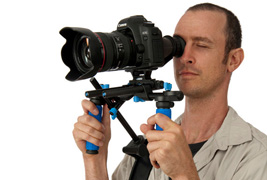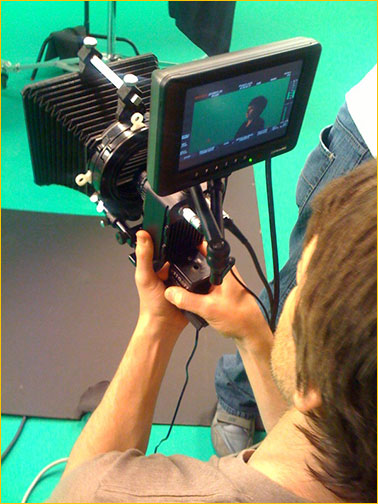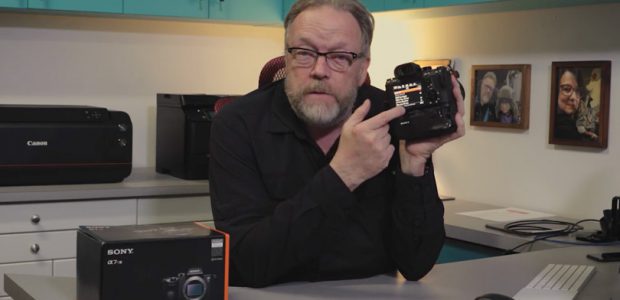The convergence of stills and video continues. An increasing number of DSLRs now have video capability. The first were theNikon D90andCanon 5DMKII, both introduced in 2008. The first half of 2009 has now seen theCanon Rebel T1i (500D),Nikon D5000, Panasonic GH1,andPentax K7introduced.
While this site’s primary focus is still-image making in all its forms, the convergence movement on the part of the camera industry requires that attention also be paid to video and video making. While there is reluctance on the part of many amateurs to adopt this blending of image making disciplines, many pros have embraced video as a new means of revenue generation, not to mention creative expression. And for creative amateurs it’s becoming clear that things don’t have to be aneither / ordecision; a great many leading photographic artists have also been filmmakers, such asRobert Frank,Henri Cartier-Bresson, andGordon Parks, to name just a few.
Since we expect that just about every DSLR introduced from now on will have video capability, It is worthwhile understanding the difference between what a Video DSLR (AKA –ComboCam) and a Camcorder each have to offer, both for the videographer and the still photographer wanting to get into video.
If the jargon and basic concepts of contemporary video are a bit unfamiliar to you, myVideo Primer for Photographersmay be of some assistance.
____________________________________________________________________________________
It’s About Shallow Depth of Field
Just as in the world of digital stills, there are categories and cameras, and then there are marketing words such asamateur,prosumer, andpro. Depending on who’s saying them and the context, these can either be explanatory or pejorative.
Video capable DSLRs like theCanon 5D MKIIhave been rapidly embraced byprofessionalandindiefilm makers for what it can do, but not because it is by any stretch of the imagination aprofessionalvideo camera.
The magic that video DSLRs offer is their large sensors (at last when compared to video cameras). No, not for the purposes of increased resolution. 1080 and 720 are what they are, and a larger sensor doesn’t provide any higher resolution. Rather, because these larger sensors allow for narrower depth of field. Of course it’s not the sensor size so much as it is that for a given aperture and focal length one gets narrower DOF with a larger sensor as a consequence of their using longer focal length lenses for the same image magnification. This is the holy grail for many film makers: the narrow DOF that allows the videographer to isolate a subject and therefore give the scene a more "filmic" look.
Combined with shooting in 24P (another filmicconceit(Def 4.b)) these are the two characteristics that North American independent film makers (Indies) try for when shooting video. In the rest of the world most video producers just don’t get it. That’s fine. I’m fairly agnostic on the subject though trending more towards embracing shallow DOF and 24 FPS the more I shoot.
The reason for this preamble is to try and shed some light on why film makers are going a bitnutsoover video DSLRs, even though these are, for the most part, not very good all-round video cameras.
They’re not– you say?How so?
____________________________________________________________________________________
What We Do and Don’t Currently Get with DSLR Video Cameras
As exciting as video-capable DSLRs are for film makers of various stripes, they lack a great deal as video cameras per se. The list below is not intended to be comprehensive, and not every feature lacking is missing on every current video DSLR. Some have one or two desirable video features, others don’t. But, for someone who looks at one of the new video DSLRs and says to themselves –self; this is all I need to shoot movies, here’s what’s often missing or problematic.
Viewfinders and Screen
Serious videographers require both an articulated LCD screen as well as an electronic viewfinder. An EVF allows for more stable shooting when hand-held, and also for clear viewing in bright sunlight. Most current Combocams (the Panasonic GH1 is the only current exception) have just an LCD screen with "Live View" video, and only a handful of the newer models have articulated screens. (A DSLR’s optical viewfinder isn’t available in LV and video modes).
A fixed LCD makes many types of shooting situations awkward at best. Having only a fixed LCD and no EVF is really like trying to shoot with one eye tied behind one’s back – to mix a metaphor.
All pro level camcorders and the top amateur handycams have both, and all higher-end camcorders have EVF’s with large eye relief, allowing glasses to be worn. Most are also articulated, so that one can look through the viewfinder while the camera is situated at a low vantage point.
Audio
Of almost equal importance to image quality is audio quality. All video capable DSLRs (Combocams, as I’ve dubbed them) can record sound, but it’s often highly compromised in several ways.
– Less expensive models often only have mono audio recording.
– Because these are primarily still cameras the controls can be noisy to operate and therefore sound can be seriously compromised.
– Audio monitoring is often missing; the ability to listen to what is being recorded through a pair of headphones. Recording sound without audio monitoring is like recording video without being able to see a screen.
– Most Combocams lack the ability to manually set audio levels, relying instead on auto gain control (AGC).
– None of the available or announced Combocams have XLR connectors. Instead they use mini-jacks which, as anyone knows who has used these on location, are the work of the devil. They break and come loose if you look at them the wrong way. XLR connectors are industrial strength and used in pro gear. Anything else is a disaster waiting to happen.
Power Zoom
– Combocams, being DSLRs at their heart, lack power zooms, which virtually all video cameras have as a matter of course. Amateurs use zoom more than is good for them (or their audiences), but having the smoothness of a power zoom mechanism when needed is welcome, and very hard if not impossible to emulate on still camera zoom lenses without expensive and bulky accessory gear.
Peaking and Zebras
– Real video cameras provide two aids to assist exposure and focus,peakingandzebras. Zebras are similar to the flashing highlights that one gets on a DSLR’s on-screen review image, but with several advantages. Firstly, they are "live" so that one can adjust exposure before shooting a single frame. Secondly, on most of the better low-end, and all the high-end video cameras, one can adjust the point at which the zebra pattern starts and stops.
Stops, you ask? Yes. For example, you can specify in the menus that the zebra pattern will only show in areas between 80% and 90% of maximum exposure. Anything above 90% will be ignored. This is great for not being distracted by zebraing on specular highlights and also large blown-out areas such as clear skies.
Peaking is the ability to set the viewfinder to show areas of greatest sharpness. On the new JVC HM100, for example, it turns the viewfinder or LCD to monochrome (which some video shooters prefer to work in in any event) and then shows edges of greatest sharpness in the image with a coloured outline, red for instance. Very handy when doing critical manual focus pulls. (Focus Pulls– manually changing focus during a shot to change the viewer’s attention to the desired subject.)
Codecs and Data Rates
Various video and still / video cameras use different video encoding schemes. These range from the inefficient (Motion JPG) to the very efficient (AVCHD). I’m referring to efficiency in terms of data compression. Video produces vast amount of data, and high resolution Progressive can be very large indeed.
The bit rate that a camera uses is also a factor. Generally, the higher the bit rate the higher the image quality, but a lower bit rate can be used when a more efficient codec is applied.
This is too great a topic to be explored here, but be aware that there’s no free lunch, and you need to understand the bit rate and the codec being used to make meaningful comparisons, and even then a big variable becomes how easy or difficult it is to work with the files.
Until very recently the highest compression codec, AVCHD, has been a real bear to work with efficiently in terms of editing, but that is now (mid-2009) changing for the better.
Resolution and Frame Rates
Proper video cameras shoot at a range of resolutions and frame rates. Current models can typically shoot at 1080i 24/30/60, 1080P 24/30, and 720P 24/30/60. No Combocams have this versatility, at least as of mid-2009.
It is important for many videographers to be able to match with footage shot on other systems. If a Combocam can only shoot 1280 X 720 (720P), for example, and the footage needs to mixed with others that are 1920 X 1080 (1080i), this can be problematic.
Worse are Combocams that shoot bizarre non-standard frame rates, such as 20FPS. Who thought that was a good idea?
Real-Time Output
Articulated LCDs and EVFs are important, but in many production environments, even fairly simple ones like low budget music videos, external monitors are demanded, and this means having live HDMI or component video output. Among Combocam only the 5D MKII, I believe, offers this.
Jello-Cam
Many advanced amateur and pro camcorders use CCD sensors and therefore do not suffer from a rolling shutter; so-calledJellocam, the effect that one sees with CMOS based video cameras, where there is a temporal difference between the time that the top of the frame is recorded as compared to the bottom of each frame. Thus, if the subject moves horizontally during a shot, or the cameras does similarly, the subject will appear to bend.
There are, of course, CMOS-based pro video cameras such as the Sony EX1 and EX3, and the Red One. And, yes, they do display some image distortion on rapid pans or subject motion, but for technical reasons (more sophisticated on-board processing chips) this is far less that is seen with Combocams.
No ND Filters
With still cameras one uses shutter speed and aperture to control exposure, along with ISO. When shooting video one has "Gain" instead of ISO, but shutter speed isn’t really available, unless one is looking for a special effect, and aperture availability is limited because with small sensors one pretty quickly gets into diffraction at smaller apertures and therefore reduced resolution.
For this reason video cameras have built in neutral density filters which can be dialed in in one, two or sometimes three stages. This enables shooting at wide apertures, even in bright sunlight. No Combocam has this capability.
Screw-in ND filters can of course be added to Combocams, but they are slower to use and therefore less convenient.
____________________________________________________________________________________
The Bottom Line
Video capability in DSLRs represents nothing short of a revolution. A new generation of photographers will embrace what they have to offer and use them to create new forms of art and commerce. In a few years we’ll likely think that a still camera that can’t also shoot video, or a video camera that can’t also shoot stills is strangely underfeatured.
Still photographers will embrace them because they provide a new tool; a new possible means of creative expression. Videographers and movie makers will adopt them because they provide convenient access to that most desirable of traits in film making:shallow depth of field.
Does a Combocam obviate the need for a video camera? Should commercial photographers adding video capability to their repertoire just use one of these, rather than also working with a Camcorder?
It’s feasible, but I would advise against it. For all of the reasons listed above, a Combocam, as good as it can be, is limited in its features and capabilities, and therefore there will remain a great many things that they simply can’t do, or at least can’t do all that well.
Does every still photographer need video. No – of course not. Many don’t, and will resent the focus on them (so to speak). I’m old enough to remember when TTL metering, auto exposure, zoom lenses, autofocus, and of course Digital were all new,andall were disparaged by the cognoscenti. That’s OK. Being an "old fart" has nothing to do with chronological age, but everything to do with head space.
____________________________________________________________________________________
Update
It’s a fast track. Within minutes of my first posting this article comesa reportthat there is now a beta release of a new unofficial firmware update for the Canon 5D MKII that adds a range of new video recording features and which also opens the door to developers producing even more nifty enhancements.
This is very cool, as long as Canon doesn’t act the spoil-sport and release official firmware updates down the road that break it the way Apple does on hacked iPhones.
June, 2009
You May Also Enjoy...
Sony a7r III Menu System Setup Video
FacebookTweet Setting Up The Sony A7r III Menus I am the owner of a number of Sony cameras, the a7r, a7r II, A9, a7r III



